On this page
Books about Herons, Bitterns and EgretsThis page lists books that are wholly or partly about Herons, Bitterns and Egrets in Great Britain and around the world. The books are listed in order of publication date with the most recent at the top.
Herons, Bitterns and Egrets
Family: Ardeidae
In the UK
Bittern (Great Bittern)
Botaurus stellaris
Grey Heron
Ardea cinerea
Little Egret
Egretta garzetta
Occasional UK visitors
Little Bittern
Ixobrychus minutus
Night Heron
Nycticorax nycticorax
Squacco Heron
Ardeola ralloides
Purple Heron
Ardea pupurea
Cattle Egret
Bubulcus ibis
Great White Egret
Egretta alba
Worldwide
There are just over 60 species of herons, egrets and bitterns in the family Ardeidae worldwide.
|
|
|
|
Cranes, Herons and Storks of AustraliaDavid Hollands
Bloomings Books
2016
"David Hollands has spent 16 years traversing Australia to find, study and photograph the 17 species which make up this book. His passion and enthusiasm for his subjects shine through in the text; lively, accurate, informative and beautifully written, not only about the birds but about the expeditions to find them. The book is richly illustrated with over 200 of the author's photographs."
|
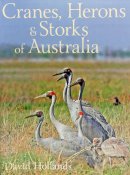 |
|
Cranes, Herons & Egrets: The Elegance of Our Tallest BirdsStan Tekiela
Advance Publishing
2015
"Award-winning photographer Stan Tekiela takes you into the fascinating world of cranes, herons and egrets. His striking photography captures the birds in action and depicts behaviors that will leave you awestruck......These historic birds are ingrained in folklore around the world. Stan has photographed every important aspect of their lives, from first flight and hunting to migration and mating.
|
Buy from amazon.co.uk 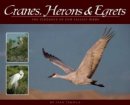
|
|
Waterbirds Of AustralianDon Hadden
New Holland Publishers
2010
"Australia supports a fascinating variety of waterbirds, from the Jabiru (more properly known as the Black-necked Stork) to two native hens. Amongst the shorebirds are about 30 migratory waders. There are ibis and spoonbills, extremely secretive and discreetly plumaged crakes and rails, and 23 species of the Ardeidae family of herons, egrets, bitterns and night-herons. All have been captured in their natural environment by nature photographer Don Hadden, following on from his Birds of Australia and Birds of the Outback."
|
 |
|
International Single Species Action Plan for the Conservation of the
Madagascar Pond-heron Ardeola idaeCompiled by Paul Kariuki Ndang'ang'a and Eric Sande
Technical Series No. 39
AEWA
(CMS Technical Series No. 20)
2008
Prepared with funding from the Italian Ministry for the Environment, Land and Sea.
From the executive summary: "The Madagascar Pond-heron Ardeola idae is listed as Endangered in the IUCN Red List. This is because it has a very small population (estimated at 2,000–6,000 individuals) which is undergoing a continuing decline. Whilst it remains fairly widespread in Madagascar, populations are low. It breeds from October to March in Madagascar, Aldabra (Seychelles), Mayotte (eastern Comoro Island, France) and Europa (Iles Eparses, administered from Réunion, to France). It has a large non-breeding range in Central and East Africa including the Comoro Islands, Mozambique, Zimbabwe, Zambia, Malawi, the United Republic of Tanzania, Kenya, Uganda, Burundi, Rwanda and the Democratic Republic of Congo; and is also a vagrant in Angola and Somalia."
|
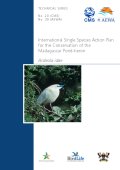 |
|
Wetland Birds of North AmericaScott Leslie
Key Porter Books
2006
This comprehensive guide covers more than 70 species of waterfowl, birds of prey, diving birds and perching birds. Information for each species includes appearance, behaviour, food, distribution/migration, related species, habitat, calls and sounds, family life, conservation concerns and a distribution a range map.
|
Buy from amazon.co.uk 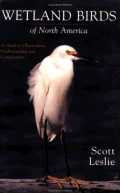
|
|
Wading & Shore Birds of the Atlantic CoastRoger S. Everett
Schiffer
2006
"The Atlantic coast, from Maryland north to New England, is part of a major flyway for migrating birds, and therefore an important destination for birdwatchers and other nature lovers. From the great variety of birds found along the shores and wetlands of the Atlantic coast noted bird photographer Roger S. Everett has selected forty beautiful images to be in this new book of postcards. Perforated, they can be detached and sent to friends (at 40 cents apiece they are a good bargain), framed and hung on your wall, or kept intact as a souvenir of your summer vacation. This is also the perfect gift for the bird enthusiast or collector of wildlife photography."
|
Buy from amazon.co.uk 
|
|
HeronsJames A. Kushlan and James A. Hancock
Colour plates: David Thelwell
Oxford University Press
2005
456 pages, numerous maps, halftones and colour plates
This volume includes 6 general chapters on the biology, feeding ecology, breeding behaviour, evolutionary relationships, and conservation of the birds in the family. The second section provides descriptions of each of the 60 species of herons, egrets and bittern, including appearance, weights, and measurements; field characters; voice; habitat and food; breeding behaviour; life cycle; and range and status (with distribution map). The book includes 8 specially commissioned colour plates by David Thelwell, showing adults of all species and many juveniles, immatures and subspecies, and 65 black-and-white drawings illustrating special features and behaviour.
|
Buy from amazon.co.uk 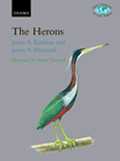
|
|
Herons, Egrets and Bitterns: Their Biology and Conservation in AustraliaNeil McKilligan
Australian Natural History Series
CSIRO Publishing
2005
"This is the first book to deal exclusively with the Australian members of the Family Ardeidae (herons, egrets and bitterns). It gives a comprehensive, easy-to-read account of their origins, classification and biology, and explains the features that distinguish them from other birds. The book devotes a major chapter to the 14 Australian species, covering their distribution and movements, feeding, breeding, population dynamics and conservation. Some of Australia's herons have become very scarce in the southern half of the continent and are at risk of national or local extinction. In northern Australia heron habitats and resources are largely pristine and consequently this region accommodates large numbers of certain species. A final chapter on population and conservation provides a useful summary of the present status of the Australian herons, some of whom are thriving and others who are in a very precarious position."
|
Buy from amazon.co.uk 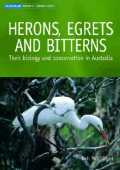
|
|
HeronsMargaret Hall
Wetland Animals series
Pebble Books
2004
|
Buy from amazon.co.uk 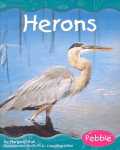
|
|
Herons and Egrets of the World: A Photographic JourneyJames A. Hancock
Poyser
2002
A review of all 47 species and recognised subspecies of Herons and Egrets that describes the appearance, distribution, conservation status, feeding, and breeding ecology of each species. Over 150 colour photographs show all the recognisable forms of each species.
|
Buy from amazon.co.uk 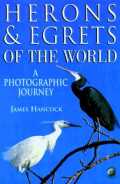
|
|
Heron ConservationEditors: James A Kushlan & Heinz Hafner
Poyser
2002
"The first part of this book reviews the status and conservation needs of herons on a regional basis, in a series of chapters set at continental or subcontinental scale. Subsequent chapters discuss a number of critical issues in heron conservation follow, often focusing on the international nature of the problem."
|
Buy from amazon.co.uk 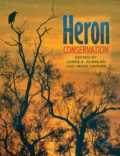
|
|
Wading Birds: From Herons To HammerheadsSara Swan Miller
Franklin Watts
2001
|
Buy from amazon.co.uk 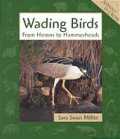
|
|
Herons of North America: Their World in FocusJames A. Hancock
Poyser / Princeton University Press
2000
A guide in words and photographs to the lives of the Herons of North America and the often endangered habitats in which they live. Includes over 100 colour photographs.
|
Buy from amazon.co.uk 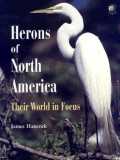
|
|
Herons and Egrets of the World: A Photographic JourneyJames Hancock
Princeton University Press
1999
"In this book, the only complete review of the world's herons currently in print, James Hancock distills his knowledge into a concise review of all 47 species and recognized subspecies. The text comprises a thumbnail sketch, including descriptions of the appearance, distribution, conservation status, feeding, and breeding ecology of each species. Over 150 wonderful color photographs, most by the author, show all the recognizable forms of each species, illustrating the variety and beauty of these birds. As a valuable reference and a fine photo collection, this book will find a place on the shelves of bird lovers everywhere."
|
Buy from amazon.co.uk 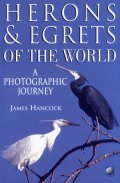
|
|
Wetland Birds: Habitat Resources and Conservation ImplicationsMilton W. Weller
Cambridge University Press
1999
A study of the ecology of wetland birds that identifies patterns of habitat use and typical bird communities that result from the use of resources such as food, cover and breeding sites.
|
Buy from amazon.co.uk 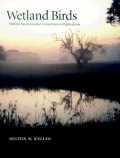
|
|
Investigation of the Feeding Sites of Grey Herons Ardea Cincerea Producing Deformed Chicks at the Besthorpe ColonyN.H.K. Burton
BTO, The National Centre for Ornithology
1998
A 34 page report.
|
Buy from amazon.co.uk |
|
The Great Blue HeronRobert Butler
University of British Columbia Press
1997
This traces a year in the life of the great blue heron through a year on the coast of British Columbia. The chapters of the book are: Introduction The Seashore Sentinel; The Northwest Coast Great Blue Heron; The Coastal Realm of the Great Blue Heron; Foraging, Food, and Diet; Social and Territorial Behaviour; Breeding Season; Choosing Where to Live; Life History Traits and Population Dynamics; Conservation of Herons and the Strait of Georgia Ecosystem; Epilogue; Historical Records of Great Blue Heron Colonies on the British Columbia Coast; Length-Mass Regression Equations of Fish Caught in Beach Seines on Roberts Bank, Fraser River Delta, BC; Effect of Increased Disturbance on Heron Populations; List of Common and Scientific Names Used in Text; and References.
|
Buy from amazon.co.uk 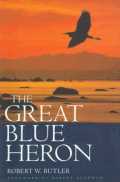
|
|
Wading Birds : Birds of the WorldJ. MacKenzie
Key Porter Books
1997
"With species that range from the familiar to the truly exotic, wading birds can be found at the margins of water all over the world. This magnificent book, which features 120 full-colour photographs from the world's top nature photographers, celebrates these beautiful creatures and includes breathtaking images of Sandhill Cranes in flights across New Mexico, Cattle Egrets perched on the head of an elephant and Tellow-billed Storks standing sentinal in a stark African tree. The informative text and extensive captions provide valuable details about these magnificent birds, including distinguishing marks, behaviour patterns and habitats. This book is a visual feast, the definitive guide for novice and veteran birdwatchers, nature lovers and conservationists."
|
Buy from amazon.co.uk 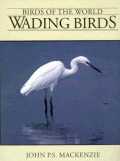
|
|
HeronsFrank J. Staub
Early Bird Nature Books
Lerner Publications
1997
An introduction to the herons of North America full colour photographs of 10 of the species and suggestions for follow-up study activities.
|
Buy from amazon.co.uk 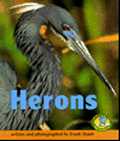
|
|
HeronsMick Marquiss
Colin Baxter Photography
1993
A48 page study of the lives and behaviour of herons with many colour photographs.
|
Buy from amazon.co.uk 
|
|
Long-legged Wading Birds of the North American WetlandsMark Riegner
Stackpole Books
1993
A study of the long-legged wading birds of North American with colour photographs by Lucian Niemeyer.
|
Buy from amazon.co.uk 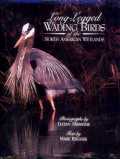
|
|
Waterbirds: The Birds of Southern Africa's WetlandsNigel Dennis and Warwick Tarboton
New Holland
1993
"Over 80 species of waterbird, including kingfishers, flamingos and herons, are described in this study of the ornithological inhabitants of the great wetlands of Southern Africa. Photographs combine with text to provide a wealth of information on the different species."
|
Buy from amazon.co.uk 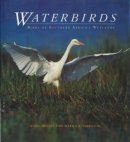
|
|
Herons of EuropeClaire Voisin
Illustrations: P.L.Suiro, Gunnar Brusewitz
Poyser
1991
This book has an introductory section providing a general description of the Heron family. Subsequent section give details of the nine species that are resident in Europe (Bittern, Little Bittern, Night Heron, Squacco Heron, Cattle Egret, Grey Heron, Purple Heron, Little Egret and Great White Egret). The species accounts cover topics such as field characters, distribution, population size, breeding and feeding ecology and behaviour. There are colour and black and white pictures of each species and line drawings showing characteristic behaviour.
|
Buy from amazon.co.uk 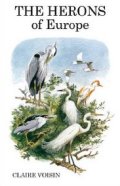
|
|
The Great Blue HeronHayward Allen
Northword
1991 (2000)
An illustrated account of the great blue heron's life cycle and behaviour as it feeds, nests and tends its young in natural habitats. Includes over 90 colour photographs of the bird nesting, flying, wading, and fishing.
|
Buy from amazon.co.uk 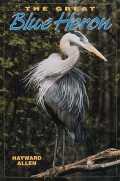
|
|
Wading Birds Of The WorldEric and Richard Soothill
Blandford
2nd edition
1989
"Describes the characteristics, behavior, habitat, distribution, food, voice, display, and breeding habits of herons, egrets, bitterns, storks, ibis, flamingoes, cranes, lapwings, plovers, curlews, snipes, and sandpipers."
|
Buy from amazon.co.uk 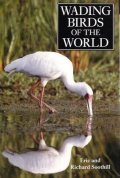
|
|
The White EgretShingi Itoh
Chronicle Books / Blandford
1988
"200 breathtaking colour photos document the life cycle of this exquisite bird, from early spring courtship and summer hatching through autumn roosting and winter migration. Ten years of diligent observation has resulted in some of the most intimate photos and knowledge of the egret."
|
Buy from amazon.co.uk 
|
|
The Wading Birds of North America: A Definitive Work Covering The United States And CanadaAllan W. Eckert
Paintings & Drawings: Karl E.Karalus
Weathervane Books / Random House
1987
Covers Herons, egrets, bittern, ibises, spoonbills, flamingos, cranes, limpkins, rails, gallinules, and coots.
|
Buy from amazon.co.uk 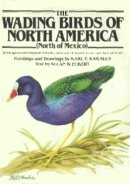
|
|
The Waterbirds of AustraliaEditor: Victor Serventy
Birds Of Australia series
The National Photographic index of Australian Wildlife
Angus & Robertson
1985
|
Buy from amazon.co.uk 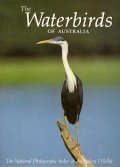
|
|
The Heron's HandbookJames Hancock and James Kushlan
Paintings: Robert Gillmor and Peter Hayman
Harper & Row / Helm
1984 / 1987
A guide to the biology, behaviour and identification of Herons, Egrets and Bitterns. This book is based on Herons Of The World (1978).
|
Buy from amazon.co.uk 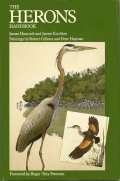
|
|
Birds of the WetlandsJames Hancock
Croom Helm
1984
"Beautifully illustrated throughout in colour from the author's own collection of photographs, this spectacular book is the work of one of the world's most-travelled authorities on wetland birds. The beauty of the bird life is set against telling explanations of how wetland habitats work and of their place in the international conservation scene. Still a haven for huge breeding populations of herons, storks, ibises, spoonbills, anhingas, cormorants, wildfowl, waders, and birds of prey, wetlands are some of the world's last and best wild places"
|
Buy from amazon.co.uk 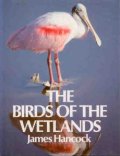
|
|
The Cattle Egret: A Texas Focus and World ViewRay C. Telfair
Texas Agricultural Experiment / Texas A & M University Press
1983
|
Buy from amazon.co.uk 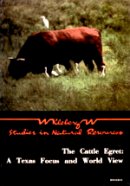
|
|
Wading Birds Of The WorldEric and Richard Soothill
Blandford
1982
|
Buy from amazon.co.uk 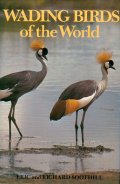
|
|
Great Blue: The Odyssey Of A Great Blue HeronMarnie Reed Crowell
Times Books
1980
|
Buy from amazon.co.uk 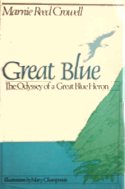
|
|
Herons of The WorldJames Hancock and Hugh Elliot
Paintings: Robert Gillmor and Peter Hayman
London Editions
1978
A review of the Herons, Bitterns and Egrets of the world which brings together and summarises current knowledge of the heron family. For each of the 61 species covered there is information about distribution, migration and habitat, general appearance and identification, and feeding and breeding behaviour. Full colour portraits by Robert Gillmor and Peter Hayman and pencil drawings by Robert Gillmor make the book a work of art as well as an authoritative monograph.
|
Buy from amazon.co.uk 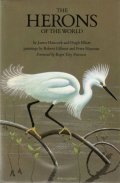
|
|
Systematics and Evolutionary Relationships Among the Herons (Ardeidae)Robert B. Payne and Christopher J. Risley
Miscellaneous Paper No 150, Museum Of Zoology
University Of Michigan
1978
|
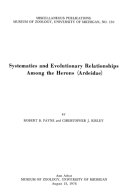 |
|
Comparative Breeding Behavior Of Four Species Of North American HeronsAndrew J. Meyerriecks
Nuttall Ornithological Club publication 2
1960
|
Buy from amazon.co.uk 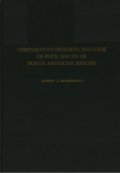
|
|
Great Blue Heron: Behavior at the NestW. Powell Cottrille, Betty Darling Cottrille
Miscellaneous Publication No. 102
Museum of Zoology, University Of Michigan
1958
"The following observations were made in a southern Michigan colony of Great Blue Herons in 1954 (March 15 to July 25) and 1955 (March 14 to June 6). The nests were in live and dead American elms (Ulrnus americana) in a stand of these elms and black cherry (Prunus serotim), cottonwood (Populus deltoides), and red maple (Acer rubrum), which is about 300 yards south of Skiff Lake, Liberty Township, Jackson County (Sec. 25, T. 4 S, R. 1 W). We counted 114 nests in 1954, about 75 of which were occupied that year. Most of the nests were situated very high in the trees; the lowest nests were about 50 feet from the ground."
|
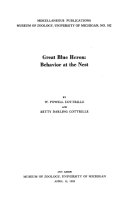 |
|
The HeronFrank A Lowe
Collins
The New Naturalist Monograph 11
1954
A 177 page study of the Heron in the UK.
|
Buy from amazon.co.uk 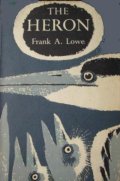
|
|
Three Studies In Bird Character: Bitterns, Herons and Water RailsLord William Percy
Country Life
1951
A 64 page study with many illustrations.
|
Buy from amazon.co.uk 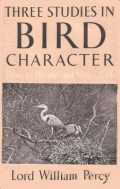
|
|
Distribution And Migration Of North American Herons And Their AlliesWells W. Cooke
21 distribution maps
Biological Survey Bulletin 45
US Department of Agriculture
Government Printing Office
1913
From the introduction: The herons have attracted wide attention during late years, particularly because of the earnest efforts that have been made to prevent the utter destruction of the aigrette-bearing members of the family. The horrors necessarily attending the collection of the aigrettes have aroused bird lovers to unprecedented activity. As a result, in some parts of the Union stringent laws have been enacted, and the State machinery for bird preservation has been supplemented by large private subscriptions. Probably no family of birds ever had fuller protection on the statute books than is now enjoyed by the herons, while certainly no birds have ever been the recipients of more zealous care than is now accorded to the remaining colonies of the larger and smaller egrets. The friends of the birds became aroused none too soon. The large breeding colonies of egrets have been completely destroyed, and only a few scattered remnants exist to serve as centers for reestablishing the species.
|
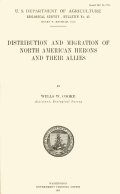
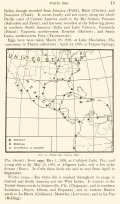 |
|
Catalogue Of The Plataleae, Herodiones, Steganopodes, Pygopodes, Alcae and Impennes In The Collection Of The British MuseumCatalogue Of The Birds In The British Museum, Volume XXVI
Plataleae and Herodiones: R. Bowdler Sharpe
Steganopodes, Pygopodes, Alcae, Impennes: W.R. Ogilvie-Grant
14 colour plates: J. Smit, J.G. Keulemans
Printed By Order Of The Trustees
Sold by: Longman & Co.; B. Quaritch; Kegan Paul, Trench, Trubner & Co.; and at the British Museum (Natural History)
1898
From the preface: "The present volume, though not numerically the last, has been, owing to various delays in its production, the last to appear. Its publication completes the series, as originally projected by Dr. Gunther more than twenty-five years ago. The whole work consists of twenty-seven volumes, and it may fairly claim to be one of the most important aids to the study of Systematic Ornithology which has ever been produced. The first volume appeared in June 1874. The others have followed at intervals averaging rather less than a year. The publication of the work has therefore been very nearly coincident with Dr. Gunther's administration of the Zoological Department of the Museum. It is to him that the general arrangement and supervision of the work is due, although each contributor has been allowed a considerable latitude in following his own views as to the details of classification and nomenclature."
|
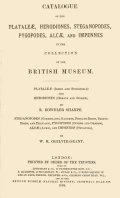
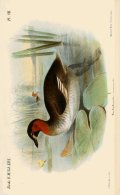
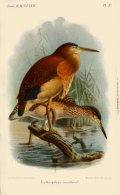 |
|
On A New Species Of Little Bittern From China
Robert Swinhoe
Colour plate (Ardetta eurythma): J.G. Keulemans
Ibis: Volume 15, Issue 1, pages 73-74
1872
Opening lines: "The Ardetta figured by v. Schrenk (Reisen im Amurlande, Vogel, t. xiii.) as the young of Ardetta cinnamomea has long been a puzzle to me. A. cinnamomea is a very common summer bird in the south of China, and, knowing it in every phase of plumage, I found it impossible to associate with it v. Schrenk's bird. What, then, could the Amoorland bird be? for no species could cross to the north of China without occurring in China itself. The doubtful bird was not A. Sinensis; with that also I was well acquainted. I could not settle the question; and it passed out of my mind until the other day, when a bird, identical with v. Schrenk's figure was brought to me - a beautiful bird, with its back all starred with white."
|
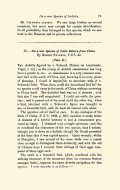
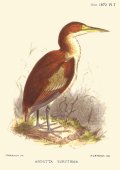 |
|